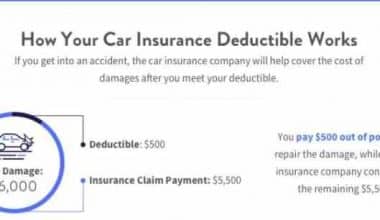Eye insurance is normally unavailable under your primary health insurance policy, but if it is, you may be eligible for benefits such as preventative eye exams and visits to an ophthalmologist, as well as prescription eyewear and contact lenses. It’s possible that having vision insurance will entitle you to a discount on vision correction procedures that are elective. The top eye insurance companies offer a diverse selection of policies, make it simple to enroll, provide coverage at affordable premium rates, and have excellent ratings for their financial stability. This post will help you learn about the most common, major, and popular companies of eye insurance.
What Is Eye Insurance?
The phrase “eye insurance” is frequently used to refer to health and wellness programs made to lower your expenses for regular preventative eye care (eye exams) and prescription eyewear (glasses and contact lenses). Additionally, some eye insurance policies include discounts for elective vision repair procedures like LASIK and PRK.
But, most eye insurance programs are discount plans or wellness benefit plans that provide certain benefits and discounts for an annual fee, as opposed to major medical insurance policies that may provide unlimited benefits after meeting certain co-pays and deductibles.
These wellness benefit plans and vision discount programs function similarly to gift cards in that they provide financial savings. They can be used to pay for the bulk of the price of standard eyeglasses or to make high-end options like progressive lenses, anti-reflective coating, and photochromic lenses considerably more reasonable.
If you’re in the market for “eye insurance,” do your research so you know what you’re getting into before making a purchase. In addition, if you have access to eye care through your employer, you should know that “eye insurance” plans typically function differently than other health insurance plans or major medical insurance.
If you want to avoid unpleasant surprises after your eye test and glasses purchase, it’s a good idea to inquire about the specific benefits of your vision plan with the office staff at your eye doctor’s office.
How Does Eye Insurance Work?
You can plan ahead for your eye care expenses with the help of eye insurance. Exams are typically covered by a flat $10 fee under most policies. You will have a set copayment for the lenses and a budget for eyewear. Your lens coinsurance will change depending on the specifics of your lens prescription (bifocal, trifocal, coatings, etc.). The majority of eye insurance plans let you spend your frame allowance on contacts instead.
In general, vision insurance will pay for the following:
- Annual checkup
- One pair of glasses every year
- Every year, or every other year, there will be a new set of frames.
For providers who are part of the plan’s network, these fees are covered. Eye insurance is similar to medical insurance in that the company provider search can be used to find doctors that accept the plan.
Also, most eye insurance companies provide a yearly or semi-annual allowance to be used toward the purchase of eyewear such as glasses or contact lenses. If you visit an in-network eye doctor, you may be able to use $100–$130 toward a new pair of eyeglasses, or the same amount can be applied toward your yearly cost of contact lenses. Refer to the strategy paper or summary for details on the precise funding.
Certain eye insurance policies may also cover Lasik, or laser eye surgery, at a discounted rate. In-network Lasik providers often receive a 15% discount off the plan’s total cost. If you need Lasik surgery, you should use your insurance company’s provider lookup tool to make sure your surgeon is in their network.
What Does Eye Insurance Cover?
There are a few things you must understand before purchasing any type of insurance. It’s important to understand not only what the plan covers, but also how it does so. If, for example, the plan only pays for one-third of the cost of a particular operation, you should be prepared to pay the remaining two-thirds yourself.
In most cases, eye insurance covers expenses for things like:
- Preventative services for the eyes, including checkups and testing (with sometimes only a minor cost).
- A set amount to spend on spectacle frames (you’ll be responsible for the difference if you want to upgrade to more expensive glasses).
- Glasses with corrective lenses
- Scratch-resistant coatings and other lens treatments
- You may be required to pay a copayment or deductible for contact lens prescriptions if you go over your plan’s allowance.
In addition, most eye insurance plans include savings on things like:
- Correctional procedures like LASIK
- Lens enhancements such as anti-reflective, shatterproof, and transition
- Gradient lenses
Various eye insurance companies provide varying degrees of protection. In most cases, less expensive insurance policies have more limitations and less benefits. The supplementary services, including lens treatments, are often included in or discounted by the premium coverage.
What Usually Is Not Covered by Eye Insurance?
Eye insurance, like other insurance policies, may not cover all of your doctor visits or medical procedures. While each policy is unique, here are some of the most typical exceptions:
- Checkups for your eyes every year following the first
- Extra glasses cases and lenses (unless you’re exchanging your current pair under warranty).
- Your optometrist may assess various fees and costs, including those for missed appointments.
- Glasses you can get at the drugstore without a prescription
- Medical care for the eyes (usually covered by health insurance).
- Care in the laboratory
How Much Is Vision Insurance?
The average person has no clue what eye care plans really cost. The truth, however, is that there is a wide range of possible prices. Choosing the right kind of insurance is usually the most important factor.
Some plans may pay for preventative care like annual checkups and glasses, while others may pay for more extensive treatment like contact lenses or even surgery.
The cost of your policy is also related to the level of coverage you decide to purchase. If, for example, you solely care about protecting your eyesight from disasters, you may get an eye insurance plan with far more limited coverage for much less money than one that covers everything.
In addition, eye insurance can be purchased from your company or a private insurance broker. The easiest way to estimate the price of eye insurance, however, is to compare quotations from different companies. You’ll know you’re receiving the best deal possible if you do this.
What Are the Advantages and Disadvantages Of Eye Insurance?
Whether or not you should purchase eye insurance depends on a number of factors, including your financial situation and the extent of your visual impairment. It could be beneficial to invest in eye insurance if you have a history of medical issues relating to your eyes. If you only need to see an eye doctor once a year for preventative care, you probably won’t find it necessary to invest in a pricey eye care insurance plan.
If you have frequent issues with your eyes or need to buy glasses frequently, eye care insurance could end up saving you money in the long run because of the low premiums. In the event that you require corrective eye surgery, it might also serve as a financial boon.
Negative aspects of vision insurance include the possibility that it will not cover the service you require or that you will be restricted from seeking care outside of the insurance provider’s network. Additionally, it may only carry a small selection of lens manufacturers, frames, and specialty lenses depending on your preferences.
Pros
- These are frequently available as add-ons to insurance packages.
- A single membership is also available for purchase.
- The cost of insurance is reasonable.
- There is a discount on glasses through the plans.
Cons
- Using services that are not part of your network may not be an option.
- Regular eye exams can be costly, especially if you don’t need them.
- The types of eyewear you can buy may be restricted by your eye insurance plan.
Where Can I Get Eye Insurance?
Companies, organizations, school districts, and other groups in addition to public health insurance programs like Medicare and Medicaid often offer group vision insurance to their employees.
Most companies of eye insurance also provide policies that may be purchased individually in case you aren’t eligible for a group plan due to your own business or for some other reason.
Health maintenance organizations (HMOs), preferred provider organizations (PPOs), and indemnity health insurers (IHIs) that have partnered with managed vision care networks to offer their members access to eye care sometimes include vision insurance as an additional benefit.
#1. HMO
HMOs are the standard type of health insurance plan. A particular amount of visits to an in-network eye doctor are covered by an HMO’s insurance plan. With an HMO, you can save money each month compared to paying for a different form of health insurance plan. However, policyholders could end up paying extra out of pocket for services that aren’t included in their plan. It’s possible that the yearly eye check waiting period will increase as well.
#2. PPO
PPO coverage is another popular option for eye care insurance. However, PPO plans allow policyholders to visit any doctor they like, regardless of whether or not they are part of the insurance company’s provider network. A PPO’s advantage over an HMO lies in its greater coverage versatility. On the other hand, PPO plans are notorious for having higher monthly premiums and greater out-of-pocket payments. Because of this, it is crucial to weigh your requirements and financial constraints when selecting a vision plan.
Who Needs Vision Insurance?
Unlike medical insurance, not everyone requires eye insurance. Those who already require eye care, such as regular eye exams, glasses, or contacts, would benefit the most from eye insurance.
Children and adults with normal eyesight can still benefit from comprehensive eye exams since they can reveal any underlying health problems. That’s why it’s important to get an eye exam when you’re in your twenties, again when you’re in your thirties, and again when you’re forties to find out how often you’ll need one after that. Additionally, the AAO suggests that people over the age of 65 get an eye exam once every two years. Related Article RETIREMENT AT 62: Health Insurance & Social Security Retirement Benefits at 62
Not all workers may find eye insurance rates worthwhile if they just need annual exams. Still, those who have a preexisting need for eye care and have vision insurance can save a lot of money.
Again, it’s crucial to learn as much as possible about the issue at hand because vision plans might differ widely.
Tips for Choosing the Right Eye Insurance
When evaluating eye insurance policies and selecting the right one for your requirements, keep the following in mind.
#1. Global Scope
Eye insurance plans with nationwide availability and a large number of participating eye care professionals are the most convenient option for most people. In fact, it’s more practical and can help you avoid coverage gaps in the case of a move or medical emergency while away from home.
More than 70,000 physicians and locations are part of the EyeMed Advantage network, while UnitedHealthcare’s vision insurance is approved at more than 120,000 locations.
#2. Reasonable Costs Each Month
The cost will be different for each strategy and level of protection. When shopping around for new vision insurance, it’s vital to keep your budget in mind and steer clear of more expensive policies if you don’t actually need the extra protection. A plan’s generous frames allowance, for instance, may not be necessary if you don’t wear glasses, but it could be an essential component if you do.
According to our analysis, EyeMed Healthy ($5/month), UnitedHealthcare’s Plan A ($11/month), and Anthem’s Blue View Vision Value ($12/month) offer the best value for your money when it comes to vision insurance.
#3. Allowances for Eyeglasses and Contacts
Find out what your sight insurance covers in terms of glasses and contacts, both now and in the future. Frames for eyeglasses and contact lenses are covered by vision insurance up to the policy’s maximum, usually $150 or $200. In some cases, you may have to choose between contacts and frames if your annual allotment is limited. There may be a discount on the remaining prizes if you go above the limit, depending on the policy.
#4. Simple Accessibility
The ease with which one can learn about, enroll in, and otherwise interact with their vision insurance provider is crucial. You may learn a lot about a vision insurance provider’s actual service quality in the event of a claim by reading customer evaluations, not only about how helpful they are throughout the enrollment process.
#5. Possibilities for Discount Bundles With Your Existing Insurance
Many eye insurance companies offer discounts to consumers who purchase multiple policies from them at once. A cheaper vision insurance plan may result from this. In addition, it might spare you the trouble of keeping track of many policies and payments to various insurance companies.
Overview of the Top Eye Insurance Companies
Here are some of the top eye insurance companies you might want to consider.
#1. VSP Vision Care
VSP is the largest eye insurance business in the country, serving one in four Americans who utilize eye care services. This means the service has access to over 40,000 eye doctors and specialists around the world.
Standard, EasyOptions, Enhanced, and Eyewear Only are just some of the VSP plan options available to you. Standard coverage appears to be available nationwide, and in some areas, buyers may acquire it for as little as $11.20 per month. However, plan availability and rates vary by location. You can enlist at any moment, and you may start receiving benefits the very next day.
Lenses (single vision, bifocal, and trifocal) are covered by VSP, as they are by other vision insurance providers. Additional features, like scratch- and glare-resistant coating and progressive lenses, are discounted, however. Retirees, the elderly, and diabetics, who are at increased risk for eye problems, are eligible for further reductions.
VSP’s frame allowances vary by plan, but in general, you can expect to receive $150 to spend on most frames, $170 to spend on selected frame brands, and a 20% discount on anything over your allocation. Unfortunately, you can’t use both your VSP allowance and your Medicare frame allowance together to pay for your glasses, as VSP does not coordinate benefits with Medicare.
VSP ranked third in the 2022 U.S. Vision Plan happiness Study, behind only Aetna Vision and United Healthcare Vision, indicating above-average customer happiness within VSP’s subscriber base.
#2. United Healthcare
Most insurance policies won’t pay for LASIK because it’s a cosmetic operation. This leaves patients on their own to pay anywhere from $1,000 to over $3,000 for each eye for surgical repair of their vision. United Healthcare (UHC) vision plan customers can obtain a free consultation and save up to 35% on LASIK surgery by visiting one of the more than 900 QualSight LASIK facilities. We have not found a better deal on laser eye surgery.
UHC has two vision plans available. Plan A is for people who don’t need corrective lenses, and Plan B is for those who do. All policies cover a yearly eye exam with a $10 cost (in-network only), scratch-resistant coating on the lenses, a $150 frame allowance, and a fitting and evaluation for contact lenses. Plan A costs about $11 per month and Plan B about $15 per month, but these figures can vary depending on the customer’s location.
Furthermore, individuals who purchase multiple plans from UCH, such as dentistry, accident, hospitalization, or critical illness insurance, can save money. It’s important to remember that some policies, including vision plans, demand a 12-month commitment and that UHC vision insurance is not offered in Alaska, Massachusetts, Minnesota, Montana, New Mexico, or New York.
Golden Rule Insurance Company provides vision insurance for UHC, and their policies are highly rated. In addition, in J.D. Power’s 2022 U.S. Vision Plan Satisfaction Study, UHC ranked second only to Aetna as the best eye plan provider.
#3. Humana
Hearing, sight, and dental care are all included under Humana Extend policies. Preventative services like eye exams, hearing tests, and dental cleanings are immediately covered upon enrollment.
Humana Extend plans have monthly premiums starting at about $40, though this varies by region. The pricing structure is transparent, and comparing plans is a breeze on Humana’s website. Humana Extend 1250, the entry-level plan, provides coverage for all types of dental care (major, preventative, and basic) and includes a teeth-whitening benefit. In order to receive a vision allowance for lenses and frames, you will need to upgrade to either the Humana Extend 2500 or 5000 plans.
The 1250 plan requires a six-month waiting period before minor dental work is covered and a full year before extensive dental work is covered. The waiting periods for basic dental care are shortened to 90 days and major dental work is reduced to six months with the more expensive plans. There is no deductible with Humana eyesight coverage.
The plans offered by Humana are less adaptable than the alternatives. Once your plan has begun, for instance, you will not be able to terminate it or receive a refund. Disenrolling from your plan or canceling your coverage often requires you to wait until after the plan’s effective date. Humana does not provide coverage for LASIK since it is considered a cosmetic procedure. Instead, it provides rebates ranging from 5% to 15%.
In 2022, J.D. Power conducted a study on the satisfaction of U.S. vision plans, but Humana wasn’t included.
#4. Ameritas
Insurance for millions of Americans is provided by the large Ameritas company. There are no deductibles or copayments with most of its vision insurance plans, and members get access to vision care networks like VSP and EyeMed, as well as a yearly eye test. In addition, clients receive a $130 frame allowance with an in-network provider or a $70 frame allowance with an out-of-network provider.
Ameritas has an unsatisfactory reputation with the Better Business Bureau (just one star out of five) and doesn’t seem to address customer concerns posted there. certain customers have also voiced dissatisfaction with the business’s service hours, which run from 7 a.m. to 6:30 p.m. Eastern Time, suggesting that certain customers may not be able to get assistance at convenient hours. Furthermore, there appears to be a fee involved with making electronic claims, and crucial information like the claims procedure specifics is lacking on Amerita’s website.
#5. EyeMed
Plans from EyeMed’s vast network of providers can be had for as little as $5 per month and as much as $30 per month. Large contact lens benefits are available in its more expensive plans.
However, EyeMed provides “Healthy,” “Bold,” and “Bright” grades of coverage. The most economical plan, Healthy, is only $5 per month and includes a yearly eye checkup with no out-of-pocket costs and discounts of 35% on frames, 15% on contacts, and 30% on premium progressive lenses.
The frame or conventional contact lens allowance for EyeMed Bold is $130, whereas the allocation for EyeMed Bright is $200. Both plans cover annual eye exams with a $10 fee and provide additional discounts on glasses (up to 20%) and contacts (up to 15% off regular lenses but not disposables) up to $210.
Plans for families are significantly more expensive than the $5 to $30 per month that individuals pay for their own coverage. The monthly premium for a family of four (two adults, two children) is three times that of a single adult or a single child. Nonetheless, all plans include savings, such as 30% off non-covered items and 15% off the retail price of LASIK surgery, and 40% off additional pairs of prescription eyeglasses.
EyeMed is a widely accessible choice due to its availability in 48 states. J.D. Power’s 2022 U.S. Vision Plan Satisfaction Study found, however, that it ranked extremely poorly compared to its rivals.
#6. Davis Vision
There are three different Davis Vision by VersantHealth plans available: Essential, Classic, and Premier. In addition, members of the same family can choose to see any licensed optometrist of their choosing.
Davis Vision doesn’t list prices on its site, although parent firm VersantHealth promotes plans with monthly premiums between $12.1 and $24 (depending on location). Members can get an annual eye test for a low fee (about $20) and have up to $200 a year to spend on glasses or contacts.
Discounts on LASIK and other specialist eyeglasses may be available via Davis Vision, depending on the plan you subscribe to. If either the frames or the lenses fail within the first year of purchase, Davis will replace them at no additional cost under its unconditional warranty.
Customer happiness with Davis Vision was somewhat lower than average, according to J.D. Power’s 2022 U.S. Vision Plan Happiness Study. However, this is based on data from only 1,247 people participating in an eye plan, so it may not be representative of the whole.
#7. Aetna
Aetna was named the top vision insurer in the US by J.D. Power in their 2022 U.S. Vision Plan Customer Satisfaction Study, and the company has high ratings for financial stability. The vision insurance plans offered by Aetna do not need a deductible or copayment, cover annual eye exams, and include a $130 allowance for frames or lenses, in addition to other discounts. However, no states offer vision coverage: Illinois, Kansas, Massachusetts, Missouri, New York, Virginia, or Washington. In some areas, Aetna’s dental insurance plan is the only option for vision coverage.
Major Eye Insurance Companies
Several major health insurance companies and smaller organizations specializing in supplementary insurance plans like eye or dentistry make up the industry’s major vision insurers. In terms of advantages, both choices are equivalent.
To what extent an employer provides vision coverage is part of their overall benefits package for workers who acquire their insurance via the workplace. Also, read BIGGEST INSURANCE COMPANIES IN 2023: Top Companies in the World, Us, UK & Canada
However, HealthCare.gov shoppers may rest assured that their little ones will always be covered for eye care no matter which plans they choose, while adult vision care is only included in a subset of plans. The Health Insurance Marketplace (HealthCare.gov) does not sell separate vision insurance policies. Instead, you can get eye insurance through your provider of choice or through an insurance agent or broker. Here are some of the major eye insurance companies.
#1. Blue Cross Blue Shield
Blue Cross Shield and its affiliated companies provide vision insurance to more people than any other provider. Most plans provide discount access to a large group of vision care experts at various pricing points.
BCBS’s competitive edge lies in the breadth of its insurance offerings. You can save money by obtaining vision insurance from the same company that handles your health, dental, and Medicare coverage.
You can trust your eye care coverage because BCBS is one of the top medical insurance companies.
#2. Delta Dental
One of Delta Dental’s newer offerings is a suite of vision plans known as DeltaVision. Due to Delta Dental being a network of separate entities, the specifics of each plan are determined by the region in which the patient resides. Delta Dental has a strong reputation and minimal customer complaints, despite the recent introduction of its vision plans.
With these plans, you may customize your vision coverage, including how much you pay for tests, glasses, and contacts. However, your options for receiving covered vision treatment will vary depending on which company the plan has partnered with. This could be EyeMed, Superior Vision, or VSP.
What Is the Largest Vision Insurance Company in The US?
VSP. VSP Vision Care is the largest supplier of vision insurance in the United States, with over 25 million individual policyholders. It claims to have 82 million policyholders in the United States, not counting those covered by employer group plans, therefore this is only a small part of the company’s overall business.
What Factors Influence Vision Insurance Cost?
The price of eye insurance fluctuates by a number of variables.
- Location. Your location is a major factor in determining the cost of your insurance since, like everyone else, doctors are affected by the cost of living and doing business in your area. The availability of in-network eye doctors in your location is another factor to think about when choosing an insurance plan.
- Type of coverage. Insurance that covers care from any doctor or hospital is more expensive than plans that require you to stay within a specific network. Vision care, LASIK surgery, and routine eye exams usually fall under more expensive comprehensive plans.
- Deductible. The deductible is the amount you are responsible for paying before your insurance kicks in. In general, insurance premiums are more cost-effective when the deductible is higher, whereas they are more expensive for those with low deductibles.
Conclusion
Eye insurance is a cheap way to save money on eye exams and glasses. Coverage can cost as little as $5 per month, depending on the plan and the number of people who rely on your income. With an eye plan, you’ll pay no more than $10 for the exam and $25 at most for the lenses. Then, once a year or twice a year, you’ll get a hundred dollars or more to go toward new frames.
Eye Insurance Companies FAQs
What is the largest eye care company in the world?
Alcon. It is the indisputable industry standard for eye care around the world, and its mission is to improve people’s vision to the highest possible standard. We’ve been around for more than 75 years, and now we’re the world’s leading manufacturer of eye care devices, with divisions that focus on both Surgical Care and Vision Care.
Is VSP a public company?
No. VSP Global is a private company with an estimated 5,500 employees. The business dominates at least one industry in the US with a sizable market share.
Similar Articles
- HO5: Overview, Policy forms, Charts & Insurance Guide
- FAMILY LIFE INSURANCE: Best Plans and Policies In 2023
- Best Auto Insurance For Seniors: 2023 Comparisons
- CAMERA INSURANCE: Best Camera Insurance for Photographers in 2023






